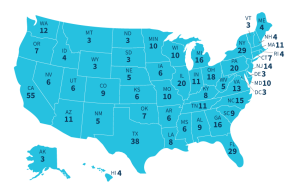Many people may believe that their vote doesn’t count during elections. Part of the reason for that feeling is based on the role of the Electoral College, according to the Constitution Day speaker.
On Constitution Day, Dr. James Hedtke, history and political science professor, explained the Electoral College and why, for example, Donald Trump lost by more that 2 million votes in 2016 but won the presidency in the Electoral College.

“The Electoral College comes into being as a multidimensional chess game,” Hedtke said. “If you play chess, you know the game is played on multiple levels. That’s how I want you to look at the Electoral College.”
The Electoral College is a system where electors officially vote for President and Vice President of the United States. This group comprises 538 electors and only needs 270 electors to vote for the same party for that party to win the presidency.
History of the Electoral College
In Philadelphia, 1787, some wanted a strong presidency and those who wished a weak presidency. The ones that wanted a strong presidency wanted the president to be elected by the people. They wanted to give the president great power while also making the people feel like they could control the president through a national election. Those who wanted a weak presidency wanted the president to be elected by Congress, which would cause the president to be weak for they would have to listen to Congress
Then there was a battle between the delegates vs. those who believed in the masses, and that the masses, through public education, could make wise decisions. During the battle, elites wanted Congress to elect a president, and those in the masses wanted the president to be elected by the people. The battle’s end result would be the Electoral College.
While the elites and masses battle was going on, there was another battle between the big and small states. The small states wanted to ensure that the president wouldn’t always come from states like New York, Pennsylvania or Virginia. The small states wanted some mechanism to elect the president so that the popular vote wouldn’t select it. Meanwhile, the large states wanted to have more control and say on the government they elected.
There were also the Federalists vs. Anti-Federalists. Federalists wanted a stronger and central government, one of the ways to have a central government was to have a popularly elected president. The Anti-Federalists, who wanted the states to have more say, pushed for an election that would be statewide rather than national. The clash between each different battle resulted in the Electoral College.
“You can see how these events played out like different levels of chess,” Hedtke said. “The Electoral College wasn’t their first choice or second choice, but it became the delegates’ final choice because of this chess game going on.”
How it Works
The Electoral College has 538 electors. Each state receives as many electors as Congress members, House of Representatives, and Senate. For example, Delaware has two Senators and one Representative, which means Delaware has three electors. There are 100 Senators and 435 members of the House of Representatives, which makes 535 Electors. The other three come from the 23rd Amendment, which awards three electors to the District of Columbia. They are elected by any manner that the state wishes. Every state plus the District of Columbia uses short presidential ballots and general tickets. The short presidential ballot is the ballot that shows you Donald Trump’s and Joe Biden’s name. This ballot doesn’t show you their set electors that you are also voting for during the election. A general ticket means that you can’t split your vote. This means if you wanted Biden to be the president, then you can’t vote Mike Pence to be the Vice President. You have to pick the democratic side or the Republican side.
“I feel like my voice isn’t being heard,” Valerie Moreno, a nursing student at Penn State College of Medicine, said. “Since the 2016 election, I felt like my vote was just thrown away and didn’t matter.”

The next president would need 270 votes out of 538 to win the presidency. If neither Trump nor Biden gets 270 votes, then the president’s election goes into the House of Representatives. In the House of Representatives, each state will have one vote, and the presidential candidate would need 26 states to win. This also means the District of Columbia does not get a vote because it’s not a state.
The people will go vote on Nov. 3, the electors will then meet on the first Monday after the second Wednesday of December. This year it will be Dec. 14. The electors will meet in their state capitals and vote for president. Each elector gets two votes, one for president and one for vice president. The votes from each of the capitals will be certified by their Secretary of state and then sent to the Congress of the United States. They count the votes on Jan. 6 and are counted by providing the Senate officers to be counted in front of Congress. The president would then be inaugurated Jan. 20.
2020 Election
As of Sept. 17, 2020, the Electoral College vote would be 212 for Biden and 115 for Trump, which would leave 211 toss-up votes. Democrats have 214 votes for the House of Representatives, and Republicans have 190, which means 31 are toss-ups votes. Democrats can maintain control if they get 4 of the 31 toss-up votes. The Senate votes are 47 Democrat and 47 Republican, which leaves six votes in a toss-up.



